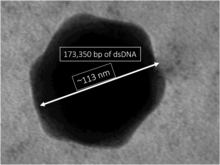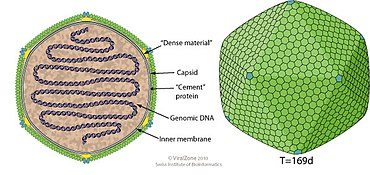Prasinovirus
| Prasinovirus | |
|---|---|

| |
| Negative stained image of MpV-SP1 | |
| Virus classification | |
| (unranked): | Virus |
| Realm: | Varidnaviria |
| Kingdom: | Bamfordvirae |
| Phylum: | Nucleocytoviricota |
| Class: | Megaviricetes |
| Order: | Algavirales |
| Family: | Phycodnaviridae |
| Genus: | Prasinovirus |
Prasinovirusis a genus of large double-stranded DNAviruses,in the familyPhycodnaviridaethat infectphytoplanktonin thePrasinophyceae.There are three groups in this genus,[1][2]includingMicromonas pusilla virus SP1,which infects the cosmopolitan photosynthetic flagellateMicromonaspusilla.[3]
There is a large group of genetically diverse but related viruses that show considerable evidence oflateral gene transfer.[4][5]
Taxonomy
[edit]
The genus contains the following species:[2]
- Micromonas pusilla virus MpVs
- Ostreococcus tauri virus OtVs
- Ostreococcus lucimarinus virus OlVs
- Bathycoccus prasino virus BpVs
- Bathycoccus sp. clade II virus BIIVs
Structure
[edit]
Viruses inPrasinovirusare enveloped, with icosahedral and round geometries, and T=169 symmetry. The diameter is around 104-118 nm.[1]
| Genus | Structure | Symmetry | Capsid | Genomic arrangement | Genomic segmentation |
|---|---|---|---|---|---|
| Prasinovirus | Icosahedral | T=169 | Enveloped | Linear | Monopartite |
Life cycle
[edit]Viral replication is nucleo-cytoplasmic. Replication follows the DNA strand displacement model. DNA templated transcription is the method of transcription. The virus exits the host cell by lysis via lytic phospholipids. Alga serve as the natural host. Transmission routes are passive diffusion.[1]
| Genus | Host details | Tissue tropism | Entry details | Release details | Replication site | Assembly site | Transmission |
|---|---|---|---|---|---|---|---|
| Prasinovirus | Alga | None | Cell receptor endocytosis | Lysis | Nucleus | Cytoplasm | Passive diffusion |
References
[edit]- ^abc"Viral Zone".ExPASy.Retrieved15 June2015.
- ^ab"Virus Taxonomy: 2020 Release".International Committee on Taxonomy of Viruses (ICTV). March 2021.Retrieved22 May2021.
- ^Cottrell, Matthew T.; Suttle, Curtis A. (1991)."Wide-spread occurrence and clonal variation in viruses which cause lysis of a cosmopolitan, eukaryotic marine phytoplankter," Micromonas pusilla "".Marine Ecology Progress Series.78:1–9.Bibcode:1991MEPS...78....1C.doi:10.3354/meps078001.ISSN1616-1599.
- ^Bellec, Laure; Grimsley, Nigel; Derelle, Evelyn; Moreau, Herve; Desdevises, Yves (2010). "Abundance, spatial distribution and genetic diversity of Ostreococcus tauri viruses in two different environments".Environmental Microbiology Reports.2(2): 313–321.doi:10.1111/j.1758-2229.2010.00138.x.PMID23766083.
- ^abFinke, Jan F; Winget, Danielle M; Chan, Amy M; Suttle, Curtis A (2017)."Variation in the genetic repertoire of viruses InfectingMicromonas pusillareflects horizontal gene transfer and links to their environmental distribution ".Viruses.9(5): 116.doi:10.3390/v9050116.PMC5454428.PMID28534829.
